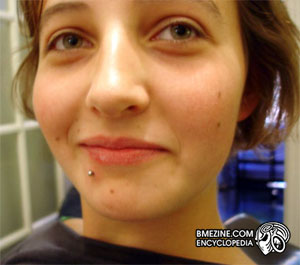Labret Piercing
Introduction
The Labret is a piercing through the lower lip.
Pronunciation
It is commonly mispronounced "luh-bray" when the actual pronunciation is "lay-bret" (/leɪ.brɛt/). 1 The "t" is not silent as it is not a loan word from French.
Placement
Placement is important since a too-short bar can actually sink into the lip. In addition, on some people the jewelry can rub on the gum, causing it to recede. When a ring is intended to be worn in this piercing it is commonly done at a slight angle to keep the ring from rubbing on the teeth. Avoid the inferior labial artery that supplies in blood all the muscle around the mouth. That's visible with a powerful light. Two labrets on each side of the lip are commonly referred to as "Snakebites", when captive bead rings are worn. Three Labrets is occasionally referred to as "Spider Bites".
Procedure
The desired placement of the piercing is marked, then Foerster clamps are aligned to the mark and used to pull the lip away from the jaw to a horizontal angle. Then a Piercing Needle is pushed through the lip, followed by the jewelry. The needle is removed along with the clamps, then the jewelry is secured. Standard labrets are pierced from the outer skin of the lower lip to the inside of the mouth. Some piercers admit that piercing from the inside of the mouth to the outer skin would be relatively painless.
Healing and aftercare
Labret piercings usually heal in approximately 2 to 3 months. PRODUCTS YOU CAN USE: Saline solution! Saline is the key to a quick healing – it balances piercings so you can heal faster! The easiest and most accurate way to acquire saline is in the form of SALINE SOLUTION FOR CONTACT LENSES. Preferably, the sterile type in a pressurized can with no preservatives (Most preservative free saline solutions will say “For Sensitive Eyes”, but read the label to make sure!). Do not use contact cleaning solutions or soaking/enzyme solutions.
HOW TO CLEAN YOUR PIERCING: Saline Soak: Heat a small amount of saline in a small clean plastic cup in the microwave. Place this solution in a position that will soak the piercing. For instance, hold the cup over your navel or nipple and lie back or use cotton balls, gauze, or a clean paper towel for hard to get piercings. Leave the warm saline solution there until it is cold, then rinse the piercing with fresh saline solution. Do this AT LEAST once per day. Saline Rinse: Soften any “crusties” on the jewelry and the surrounding skin without turning the jewelry (soaking does a tremendous job – see above). Gently clean any lymph (crusties) away from the piercing using a clean Q-tip and additional saline without turning the jewelry. Do this a few times a day, when activity may cause the ring to turn (exercise, etc.), and anytime the jewelry feels “sticky” or uncomfortable until your piercing is healed.
NEVER move the jewelry back and forth through the piercing – it does way more harm than good. Labret piercings require special care. Care for the external part of lip is stated above. Below is the recommended care for the oral part. WHAT YOU WILL NEED: 1. Biotene® or sea salt (non-iodized) to rinse your mouth. 2. Ice for tongue piercings (it may help a little for lips too). WHAT TO DO: Rinse your mouth with Biotene® or sea salt (1/4 tsp. Per cup of water) after you eat or drink, but primarily after meals, for the first 4 to 6 weeks. If your piercing is sore and/or swollen, some Alive® (naproxen sodium) or Advil® (ibuprofen) may help – please only use over-the-counter drugs according to their instructions and with your physician’s approval. Rinse the piercing with saline to keep it balanced and help heal faster. Do not play with it! If you leave them alone, they will heal fast. Alternate sides if you have fishtail labret jewelry for at least a couple hours every day (or at night while sleeping) to prevent the inside lip tissue from “growing” to one side. Avoid hot and spicy food and hot drinks which will scald or increase swelling. Yogurt, bread, beer, and wine will not harm your tongue piercing, though the latter two may cause you to become drunk. NO KISSING OR SEXUAL CONTACT until it is completely healed. Keep in mind your piercing is an opening to your blood stream.
Long term health issues
Common health risks are damage to teeth from poor placement, gum recession from poor placement, and like most piercings if it is over stretched the hole may never fully close causing you to leak.
Jewelry
Most commonly done at 14g (1.6mm) or 16g (1.2mm), 16g is more typically performed on women due to the more "petite" appearance of it. It is easily stretched but like all stretching just listen to your body. The most common jewelry is a Labret Stud. When a CBR is used, the piercing is generally referred to as a lip ring. Stretched labret piercings above 12g (2mm) often require "custom" jewelry, as common jewelry for this piercing is not typically produced at larger gauges. Glass, Wood, Bioplast, PTFE and Acrylic are all good choices because they minimize tooth damage. However, if well placed and not played with excessively, metal should not be an issue.
History and culture
The labret was a piercing historically done by Native Americans and other groups. The word is from the Latin labrum, lip.
Reference
Pronunciation: [1]
See also
External links
<if there are links to materials outside BME that might be of interest to the reader - the homepage of the studio that pioneered the piercing, etc...>
